Research on the Ignition Strategy of Diesel Direct Injection Combined with Jet Flame on the Combustion Character of Natural Gas in a Dual-Fuel Marine Engine
Abstract
1. Introduction
2. Model Description and Validation
2.1. Computational Fluid Dynamics (CFD) Model
2.2. Model Validation
3. Results and Discussion
3.1. The Pilot Diesel Injection Timing
3.2. The Main Diesel Injection Timing
3.3. The Ratio of Main and Pilot Diesel
4. Conclusions
- The difference in injection time and quantity affected the development process of the main injection flame and jet flame formed by the pilot diesel. We found that the change in the main diesel in the main combustion parameters had a greater influence on combustion, emission, and power than that of the pilot diesel in the pre-chamber.
- Changing PDIT has a smaller effect on engine performance when PDIT advances from −1°CA to −5°CA. However, when PDIT is −7°CA, the peak pressure and consumption rate of CH4 decreases. This is because it is difficult to ignite the gas in the cylinder rapidly using the jet flame formed by the pre-chamber with a small quantity of diesel, leading to slow propagation of the flame in the cylinder and deterioration of combustion.
- With the advance in MPIT, the peak pressure increased, and the consumption rate of CH4 accelerated. Meanwhile, the unburned CH4 and HC emissions in the cylinder reduced as MDIT advanced, leading to an increase in engine power by 316 kW, and the thermal efficiency improved by 1.5% when MPIT advanced from −8°CA to −2°CA. However, CO2 emissions increased by 10.5 g/kWh, and NOx emissions increased by 0.7 g/kWh.
- As the main diesel ratio decreased from 100% to 90%, the maximum pressure and combustion rate of CH4 increased. Meanwhile, the engine power improved by 50 kW and the thermal efficiency improved by 0.6% as the decrease in main diesel from 100% to 90%, leading to HC emissions decreased. The CO2 emissions decreased by 4 g/kWh when MDR decreased. However, the NOx emissions decreased first and increased then with the decrease in MDR, which has no obvious change.
Author Contributions
Funding
Institutional Review Board Statement
Informed Consent Statement
Data Availability Statement
Conflicts of Interest
Abbreviations
| 3-D | Three-Dimensional |
| CFD | Computational Fluid Dynamics |
| CH4 | Methane |
| CO2 | Carbon Dioxide |
| DF | Dual Fuel |
| IMO | International Maritime Organization |
| LNG | Liquefied Natural Gas |
| MDIT | Injection Timing of Main Diesel |
| MDR | Main Diesel Ratio |
| NG | Natural Gas |
| NOx | Nitrogen Oxides |
| PDIT | Injection Timing of Pilot Diesel |
| TDC | Top Dead Center |
References
- Xing, H.; Spence, S.; Chen, H. A comprehensive review on countermeasures for CO2 emissions from ships. Renew. Sustain. Energy Rev. 2020, 134, 110222. [Google Scholar] [CrossRef]
- IMO. Fourth Greenhouse Gas Study 2020; International Maritime Organization: London, UK, 2020. [Google Scholar]
- Serra, P.; Fancello, G. Towards the IMO’s GHG Goals: A Critical Overview of the Perspectives and Challenges of the Main Options for Decarbonizing International Shipping. Sustainability 2020, 12, 3220. [Google Scholar] [CrossRef]
- IMO. Greenhouse Gas Emissions; International Maritime Organization: London, UK, 2018. [Google Scholar]
- Karczewski, M.; Chojnowski, J.; Szamrej, G. A Review of Low-CO2 Emission Fuels for a Dual-Fuel RCCI Engine. Energies 2021, 14, 5067. [Google Scholar] [CrossRef]
- Ampah, J.D.; Yusuf, A.A.; Afrane, S.; Jin, C.; Liu, H. Reviewing two decades of cleaner alternative marine fuels: Towards IMO’s decarbonization of the maritime transport sector. J. Clean. Prod. 2021, 320, 128871. [Google Scholar] [CrossRef]
- Elkafas, A.G.; Elgohary, M.M.; Shouman, M.R. Numerical analysis of economic and environmental benefits of marine fuel conversion from diesel oil to natural gas for container ships. Environ. Sci. Pollut. Res. 2021, 28, 15210–15222. [Google Scholar] [CrossRef]
- Fernández, I.A.; Gómez, M.R.; Gómez, J.R.; Insua, Á.B. Review of propulsion systems on LNG carriers. Renew. Sustain. Energy Rev. 2017, 67, 1395–1411. [Google Scholar] [CrossRef]
- Degiuli, N.; Martić, I.; Farkas, A.; Gospić, I. The impact of slow steaming on reducing CO2 emissions in the Mediterranean Sea. Energy Rep. 2021, 7, 8131–8141. [Google Scholar]
- Iannaccone, T.; Landucci, G.; Tugnoli, A.; Salzano, E.; Cozzani, V. Sustainability of cruise ship fuel systems: Comparison among LNG and diesel technologies. J. Clean. Prod. 2020, 260, 121069. [Google Scholar] [CrossRef]
- Duan, X.; Liu, J.; Yao, J.; Chen, Z.; Wu, C.; Chen, C.; Dong, H. Performance, combustion and knock assessment of a high compression ratio and lean-burn heavy-duty spark-ignition engine fuelled with n-butane and liquefied methane gas blend. Energy 2018, 158, 256–268. [Google Scholar] [CrossRef]
- Mavrelos, C.; Gerasimos, T. Numerical investigation of a premixed combustion large marine two-stroke dual fuel engine for optimising engine settings via parametric runs. Energy Convers. Manag. 2018, 160, 48–59. [Google Scholar] [CrossRef]
- Ju, D.; Huang, Z.; Li, X.; Zhang, T.; Cai, W. Comparison of open chamber and pre-chamber ignition of methane/air mixtures in a large bore constant volume chamber: Effect of excess air ratio and pre-mixed pressure. Appl. Energy 2020, 260, 114319. [Google Scholar] [CrossRef]
- Simpson, D.J.; Olsen, D.B. Precombustion Chamber Design for Emissions Reduction from Large Bore NG Engines. J. Eng. Gas Turbines Power 2010, 132, 122802. [Google Scholar] [CrossRef]
- Shin, J.; Choi, J.; Seo, J.; Park, S. Pre-chamber combustion system for heavy-duty engines for operating dual fuel and diesel modes. Energy Convers. Manag. 2022, 255, 115365. [Google Scholar] [CrossRef]
- Zhou, L.; Song, Y.; Hua, J.; Liu, F.; Liu, Z.; Wei, H. Effects of different hole structures of pre-chamber with turbulent jet ignition on the flame propagation and lean combustion performance of a single-cylinder engine. Fuel 2022, 308, 121902. [Google Scholar] [CrossRef]
- Guan, W.; He, Z.; Zhang, L.; EL-Seesy, A.; Wen, L.; Zhang, Q.; Yang, L. Effect of asymmetric structural characteristics of multi-hole marine diesel injectors on internal cavitation patterns and flow characteristics: A numerical study. Fuel 2021, 283, 119324. [Google Scholar] [CrossRef]
- Li, M.; Zhang, Q.; Li, G.; Shao, S. Experimental investigation on performance and heat release analysis of a pilot ignited direct injection natural gas engine. Energy 2015, 90, 251–1260. [Google Scholar] [CrossRef]
- Yousefi, A.; Guo, H.; Birouk, M.; Liko, B.; Lafrance, S. Effect of pre-main-post diesel injection strategy on greenhouse gas and nitrogen oxide emissions of natural gas/diesel dual-fuel engine at high load conditions. Fuel 2021, 302, 121110. [Google Scholar] [CrossRef]
- Cong, Y.; Gan, H.; Wang, H. Parameter investigation of the pilot fuel post-injection strategy on performance and emissions characteristics of a large marine two-stroke natural gas-diesel dual-fuel engine. Fuel 2022, 323, 124404. [Google Scholar] [CrossRef]
- Liu, Z.; Zhou, L.; Liu, B.; Zhao, W.; Wei, H. Effects of equivalence ratio and pilot fuel mass on ignition/extinction and pressure oscillation in a methane/diesel engine with pre-chamber. Appl. Therm. Eng. 2019, 158, 113777. [Google Scholar] [CrossRef]
- Liu, L.; Wu, Y.; Wang, Y. Numerical investigation on knock characteristics and mechanism of large-bore natural gas dual-fuel marine engine. Fuel 2022, 310, 122298. [Google Scholar] [CrossRef]
- Wang, H.; Gan, H.; Theotokatos, G. Parametric investigation of pre-injection on the combustion, knocking and emissions behavior of a large marine four-stroke dual-fuel engine. Fuel 2020, 281, 118744. [Google Scholar] [CrossRef]
- Guo, H.; Zhou, S.; Zou, J.; Shreka, M. A Numerical Study on the Pilot Injection Conditions of a Marine 2-Stroke Lean-Burn Dual Fuel Engine. Processes 2020, 8, 1396. [Google Scholar] [CrossRef]
- Tang, Q.; Ramgopal, S.; Manuel, E.M.; Priybrat, S.; Ponnya, H.; Moez, B.H.; Emre, C.; Junseok, C.; Gaetano, M.; Bengt, J. Optical diagnostics on the pre-chamber jet and main chamber ignition in the active pre-chamber combustion (PCC). Combust. Flam 2021, 228, 218–235. [Google Scholar] [CrossRef]
- Cao, Z.; Wang, T.; Sun, K.; Cui, L.; Gui, Y. Numerical Analysis of Scavenging Process in a Large Marine Two-Stroke Diesel Engine; SAE Technical Paper 2017-01-2201; SAE International: Warrendale, PA, USA, 2017. [Google Scholar]
- Wang, G.; Yu, W.; Li, X.; Su, Y.; Yang, R.; Wu, W. Experimental and numerical study on the influence of intake swirl on fuel spray and in-cylinder combustion characteristics on large bore diesel engine. Fuel 2019, 237, 209–221. [Google Scholar] [CrossRef]
- Patterson, M.A.; Reitz, R.D. Modeling the effects of fuel spray characteristics on diesel engine combustion and emission. SAE Trans. 1998, 107, 27–43. [Google Scholar]
- Zhu, L.; Li, B.; Li, A.; Ji, W.; Qian, Y.; Lu, X.; Huang, Z. Effects of fuel reforming on large-bore low-speed two-stroke dual fuel marine engine combined with EGR and injection strategy. Int. J. Hydrog. Energy 2020, 45, 29505–29517. [Google Scholar] [CrossRef]
- Özgül, E.; Şimşek, M.; Bedir, H. Use of thermodynamical models with predictive combustion and emission capability in virtual calibration of heavy duty engines. Fuel 2020, 264, 116744. [Google Scholar] [CrossRef]
- Liu, L.; Liu, S.; Xia, Q.; Liu, B.; Ma, X. Numerical Investigation on Mixing Characteristics and Mechanism of Natural Gas/Air in a Super-Large-Bore Dual-Fuel Marine Engine. Atmosphere 2022, 13, 1528. [Google Scholar] [CrossRef]
- Rahimi, A.; Fatehifar, E.; Saray, R.K. Development of an optimized chemical kinetic mechanism for homogeneous charge compression ignition combustion of a fuel blend of n-heptane and natural gas using a genetic algorithm. Proc. Instit. Mech. Eng. Part D J. Automob. Eng. 2010, 224, 1141–1159. [Google Scholar] [CrossRef]
- Liu, H.; Li, J.; Wang, J.; Wu, C.; Liu, B.; Dong, J.; Liu, T.; Ye, Y.; Wang, H.; Yao, M. Effects of injection strategies on low-speed marine engines using the dual fuel of high-pressure direct-injection natural gas and diesel. Energy Sci. Eng 2019, 7, 1994–2010. [Google Scholar] [CrossRef]
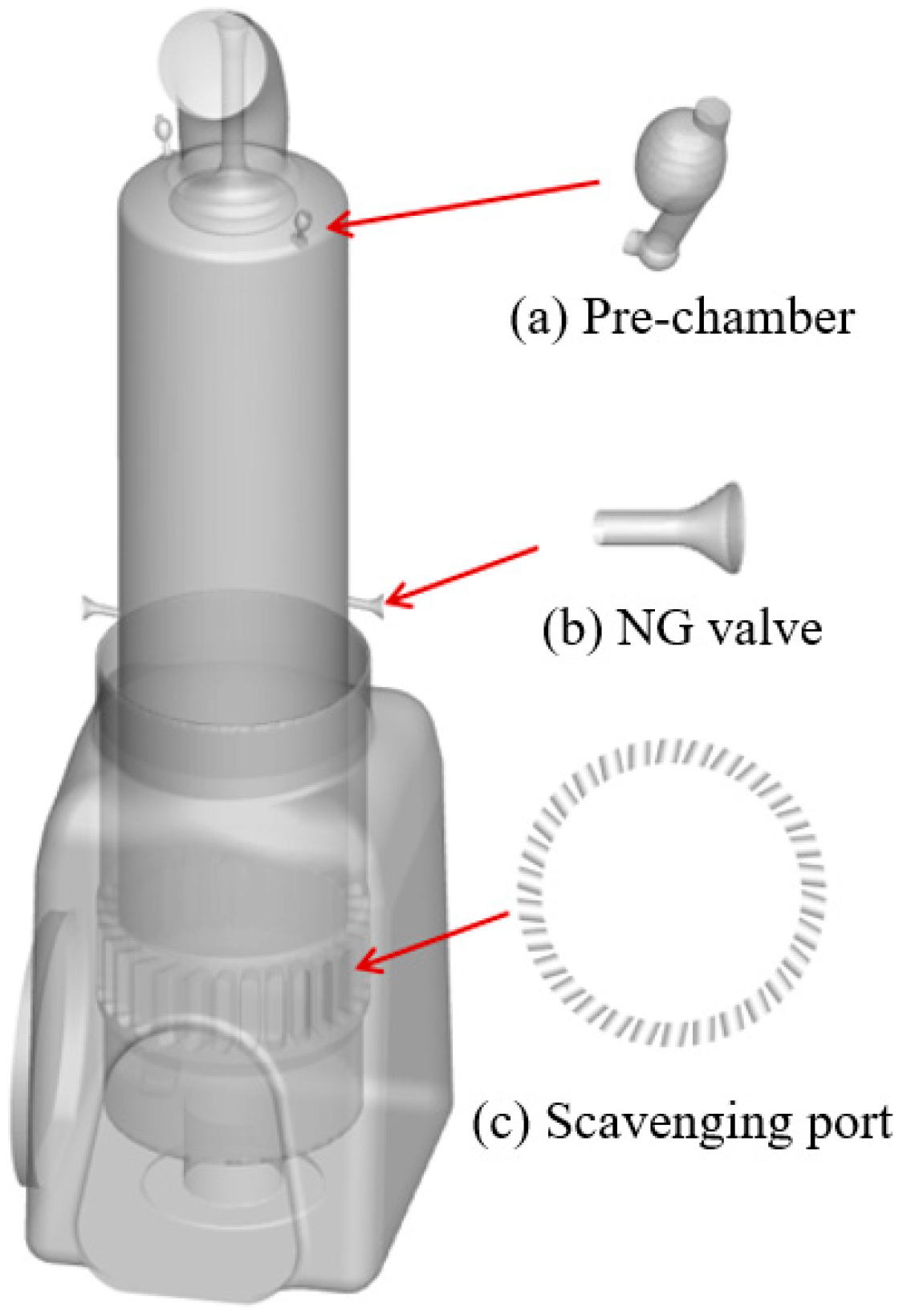
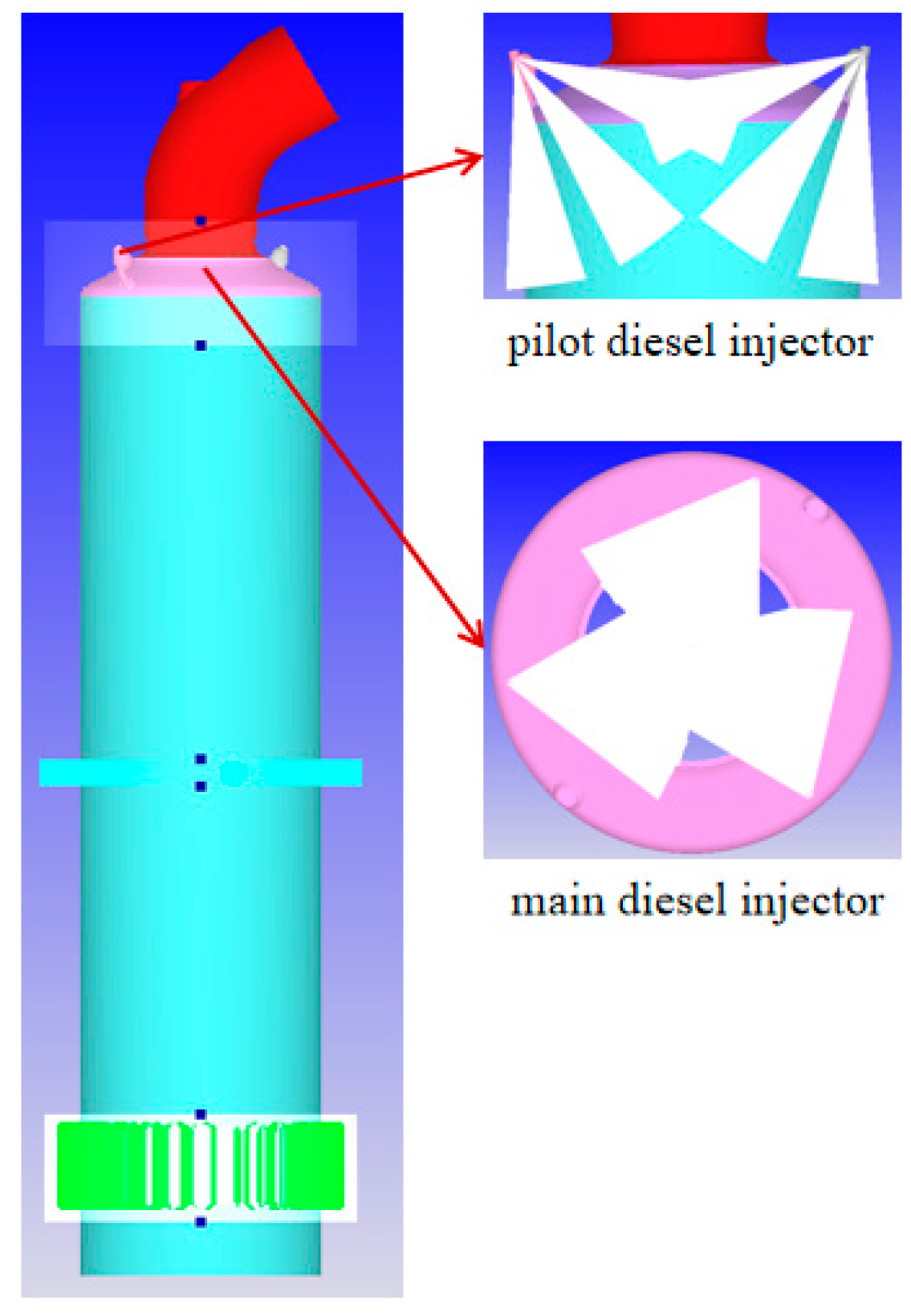

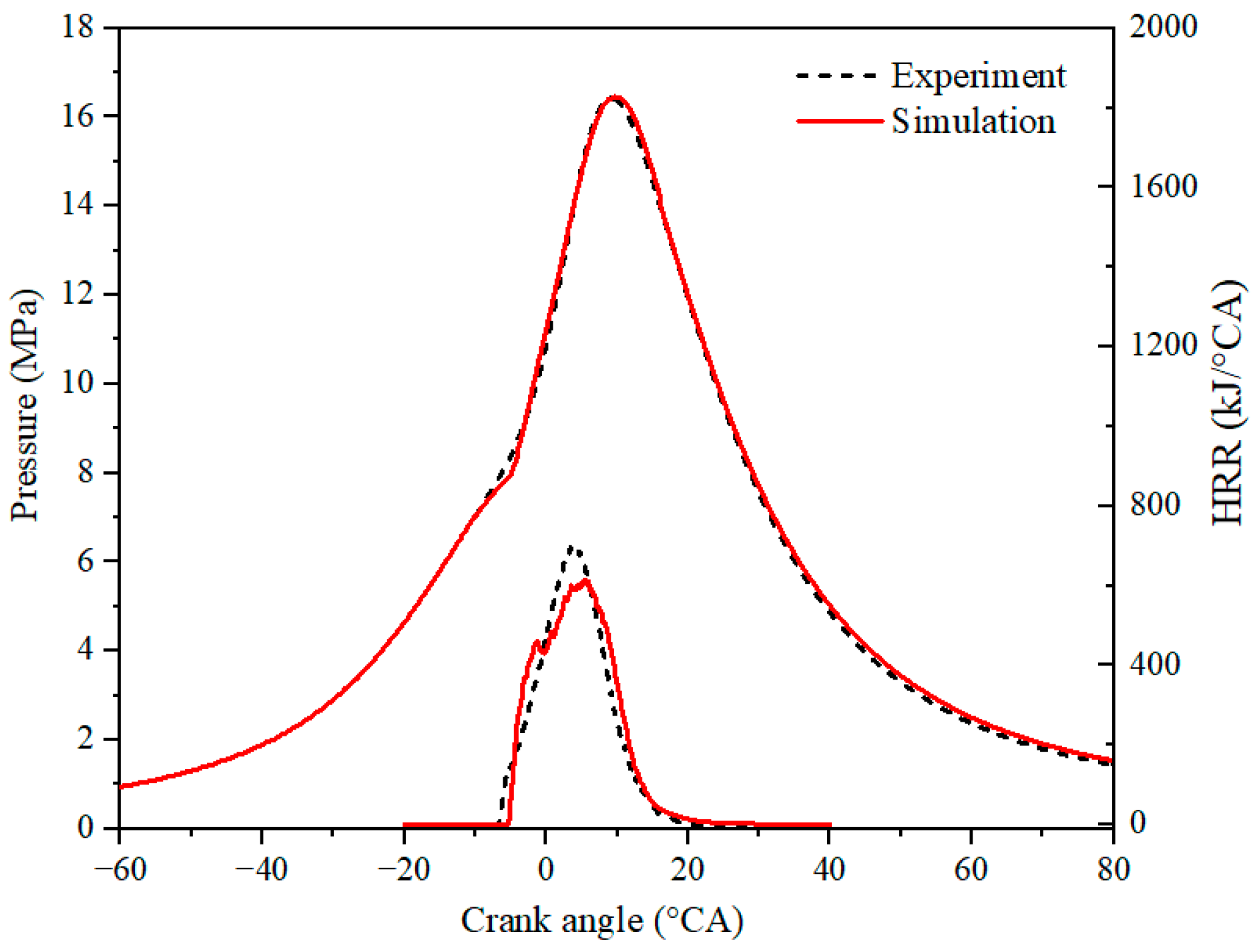
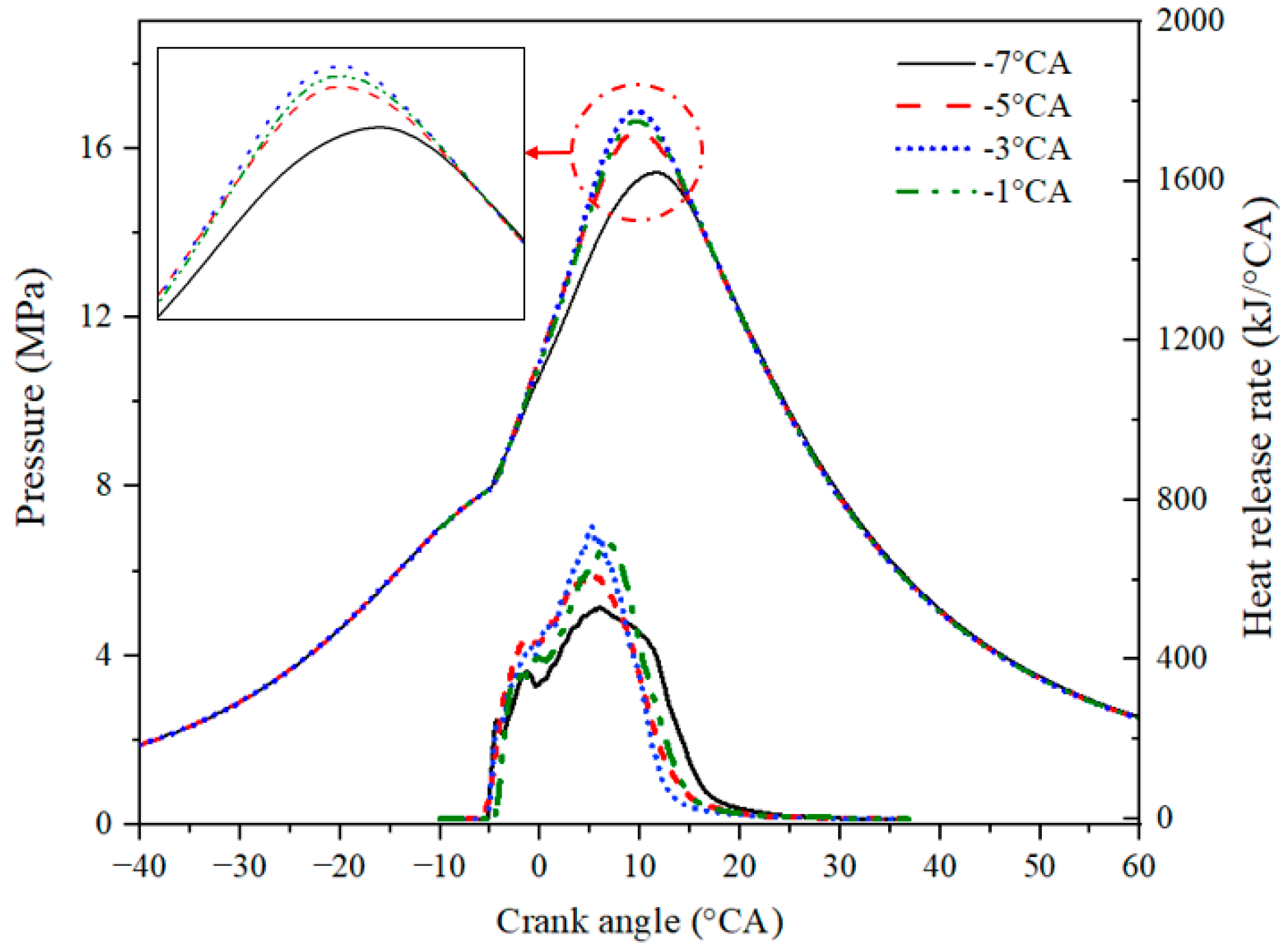
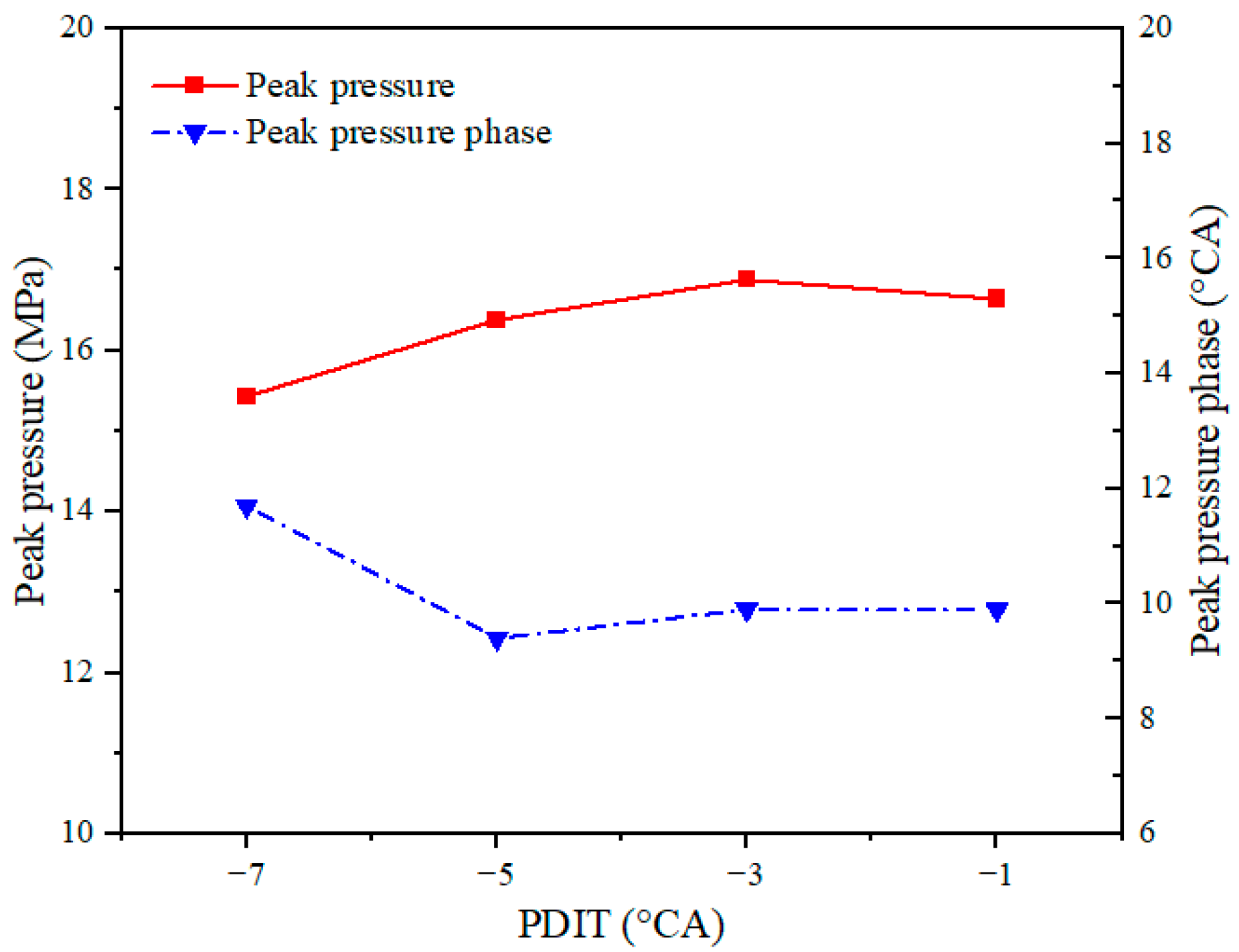
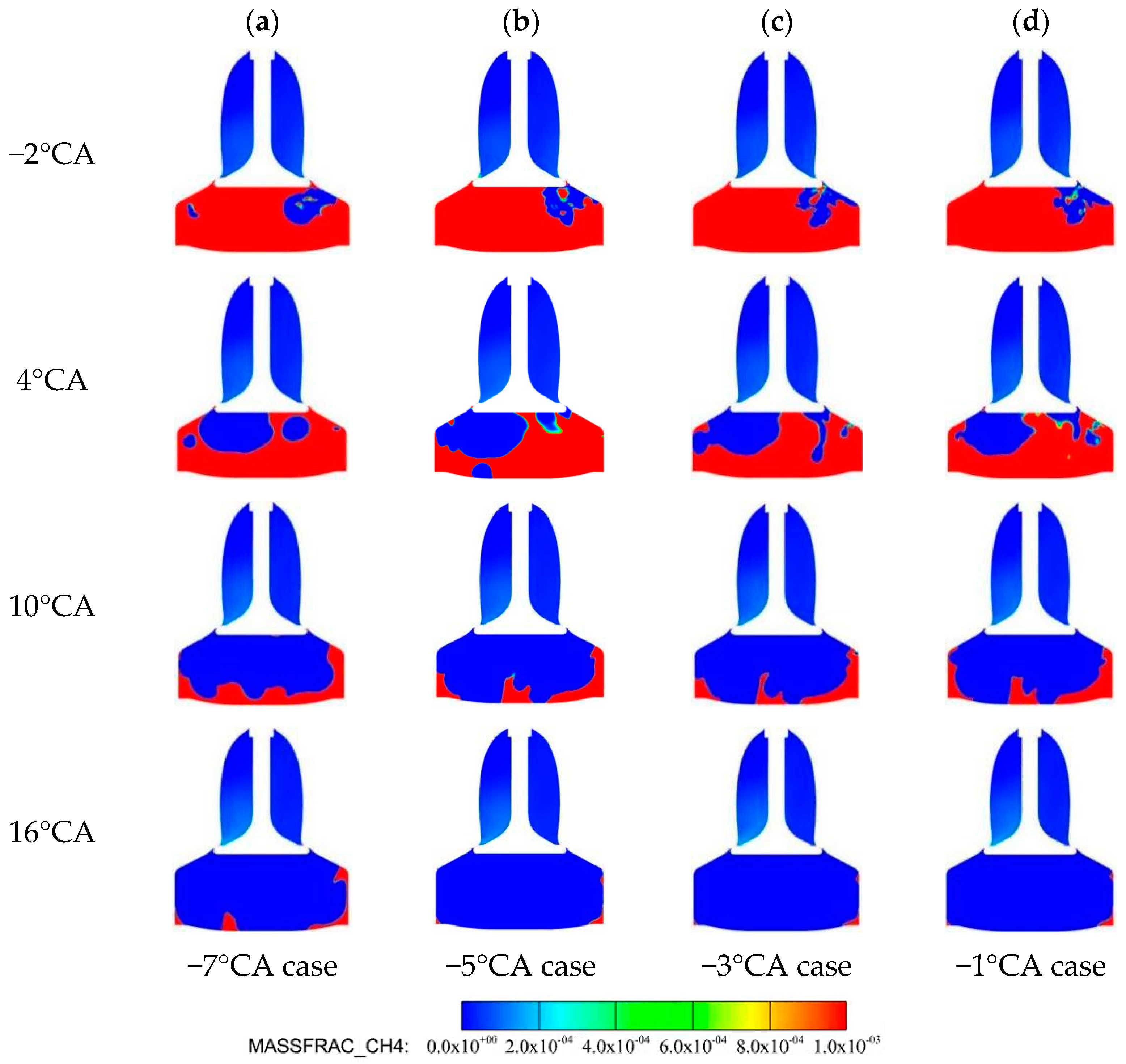
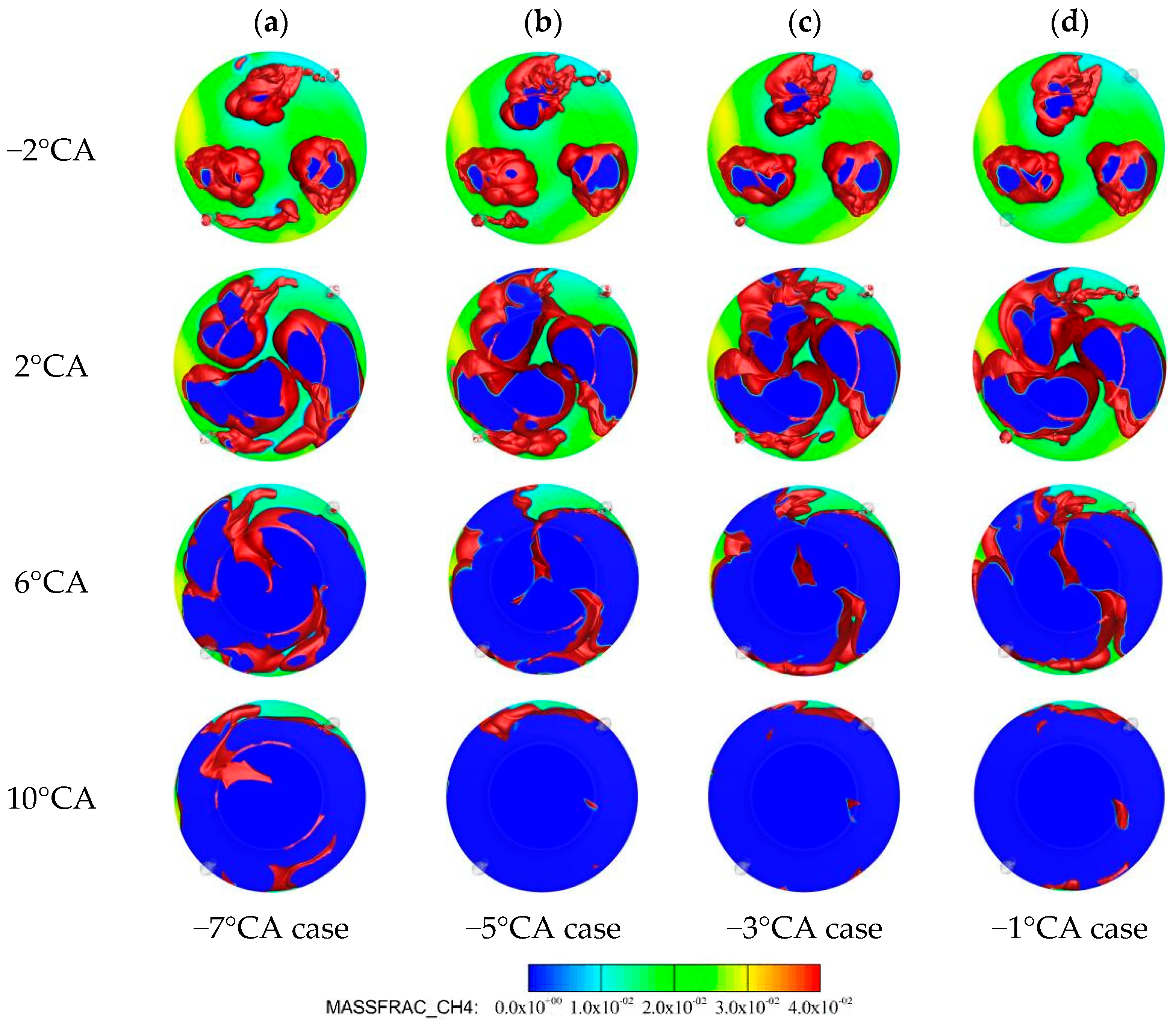

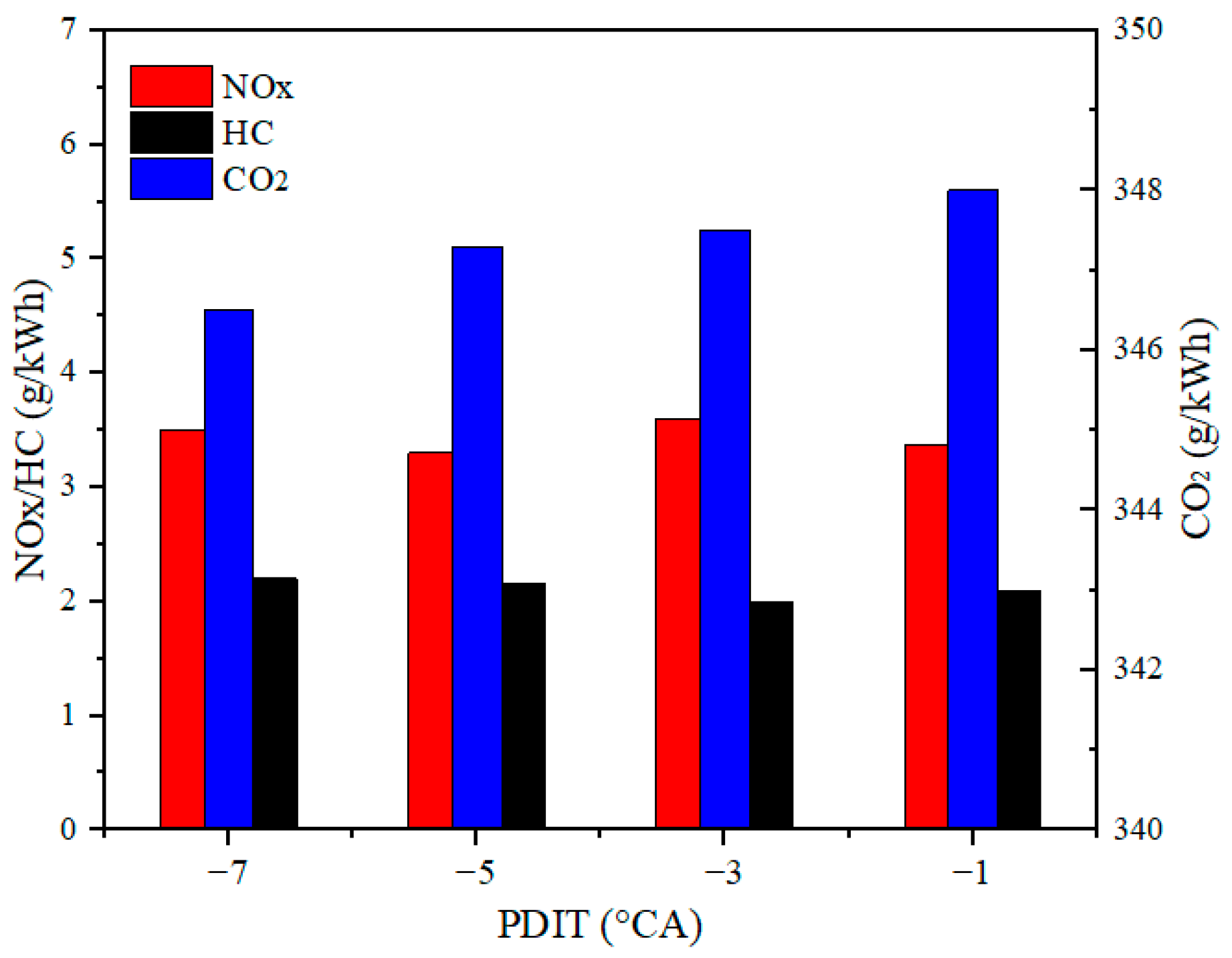
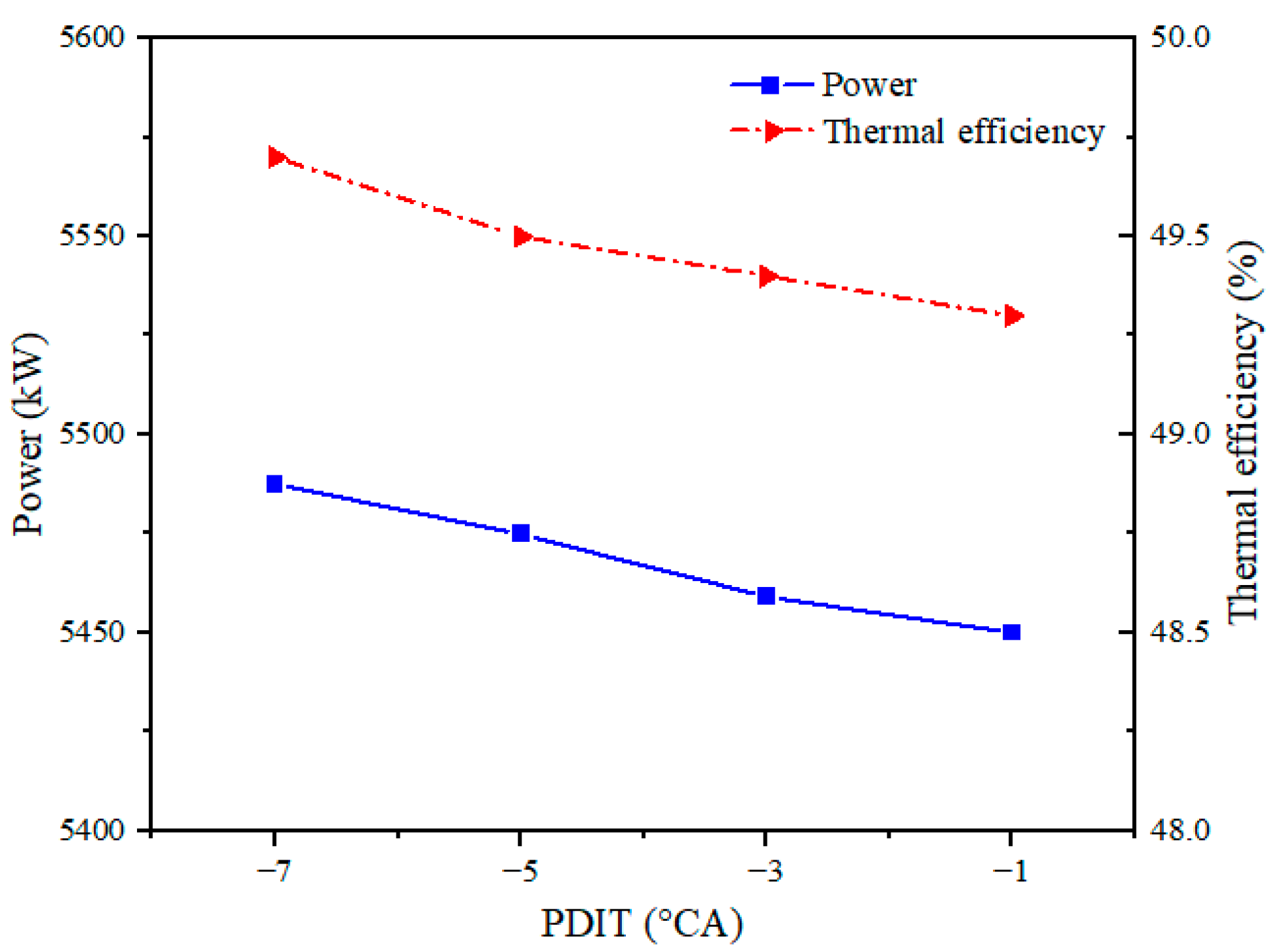
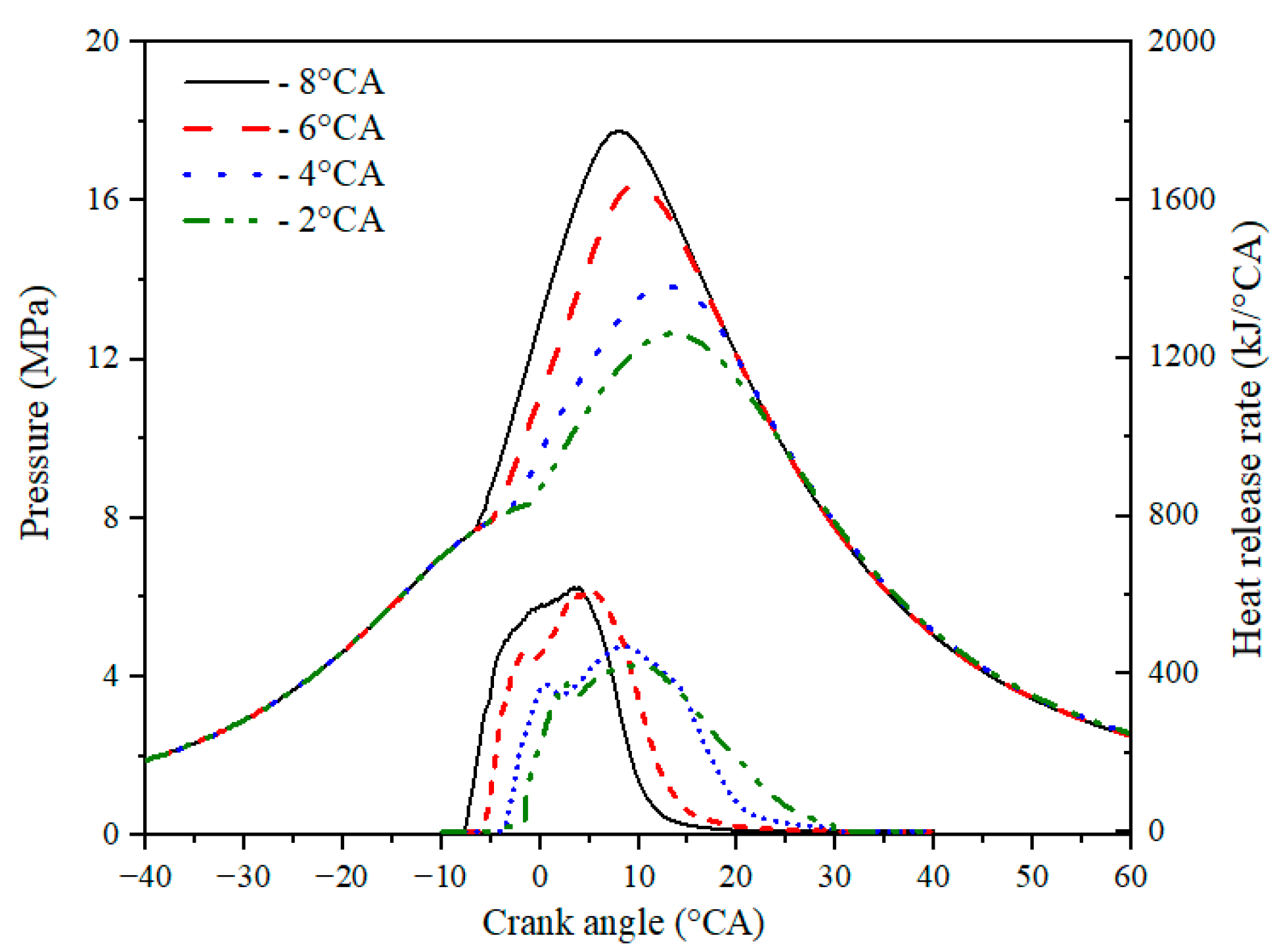
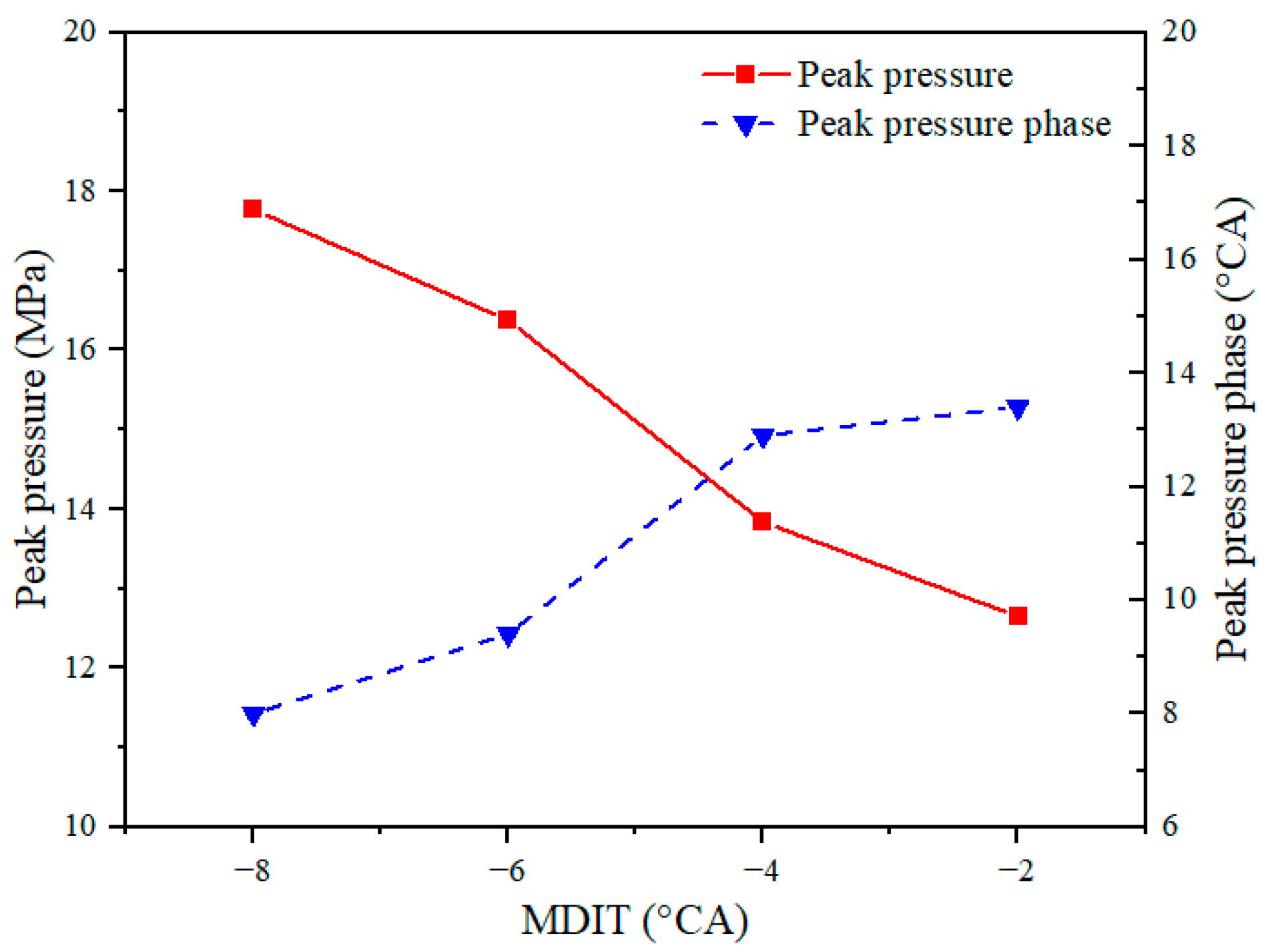

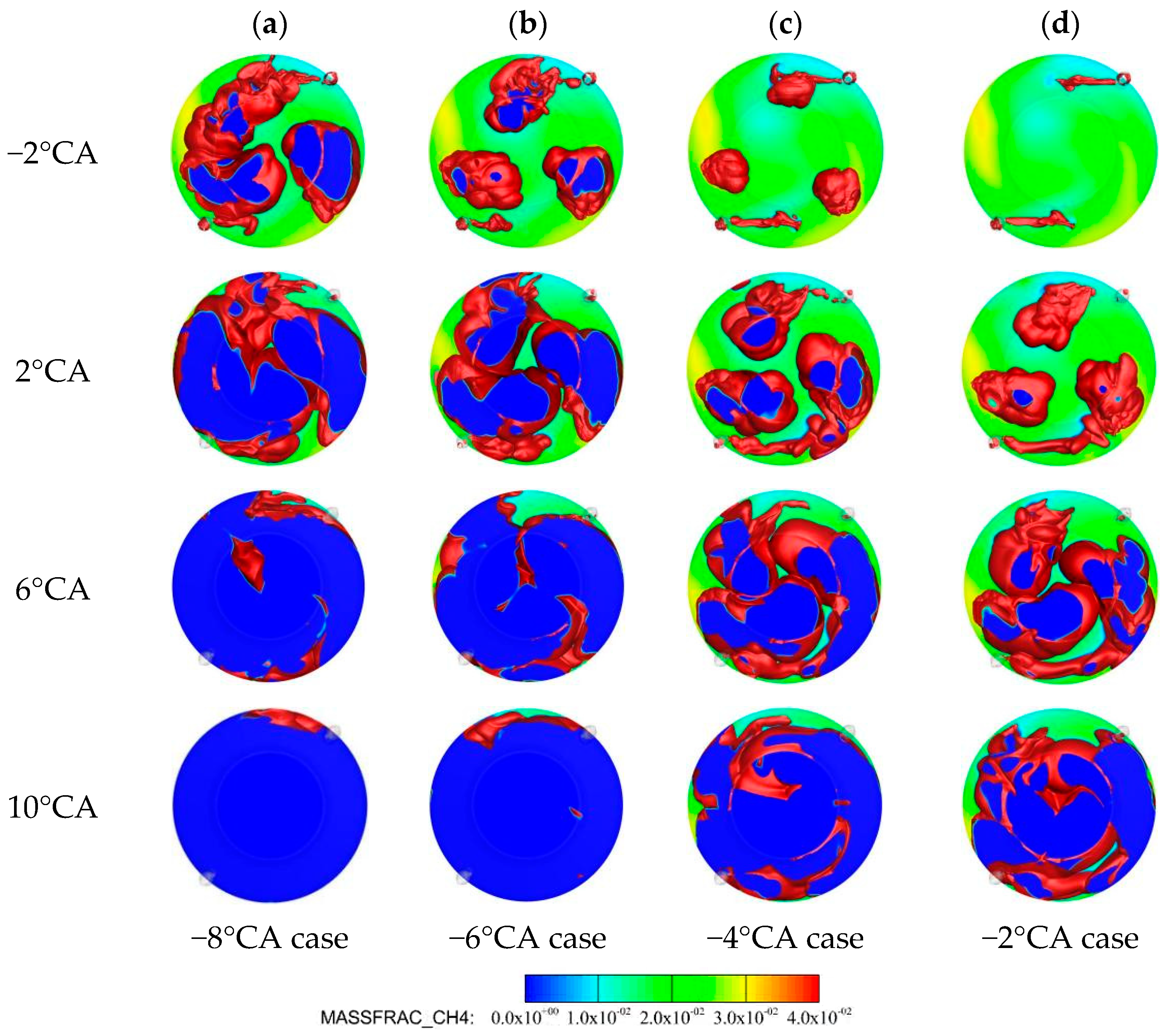


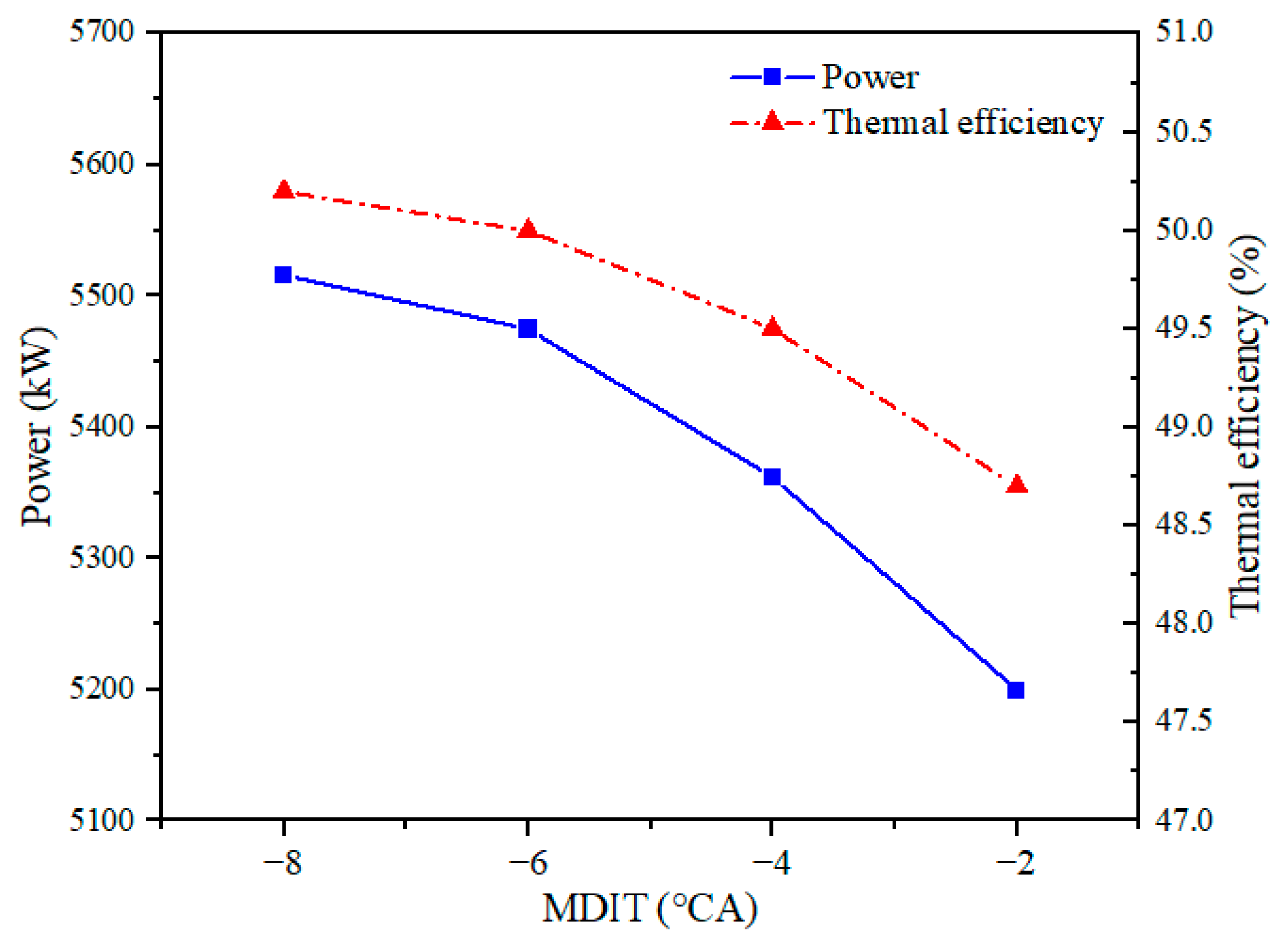
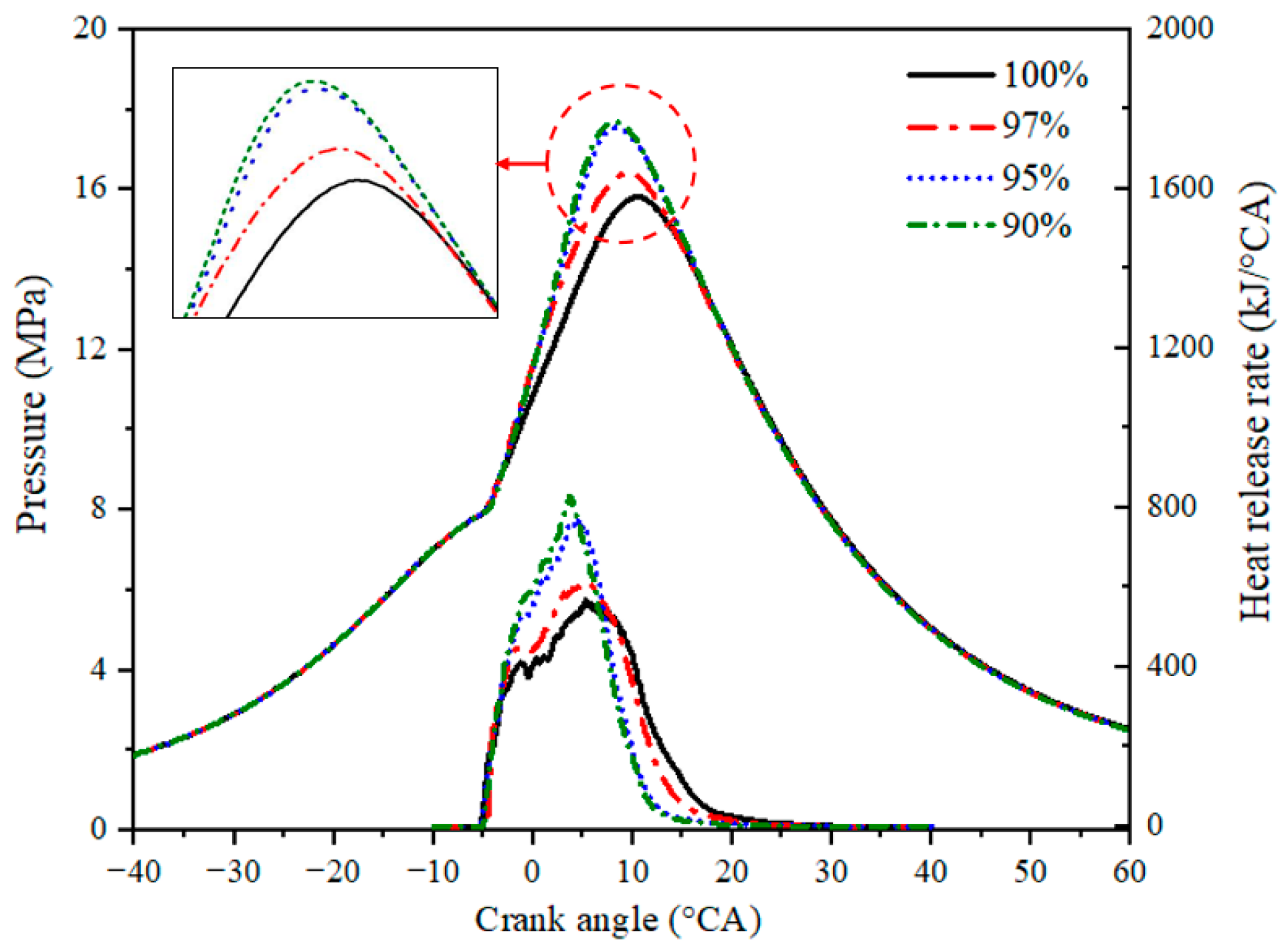
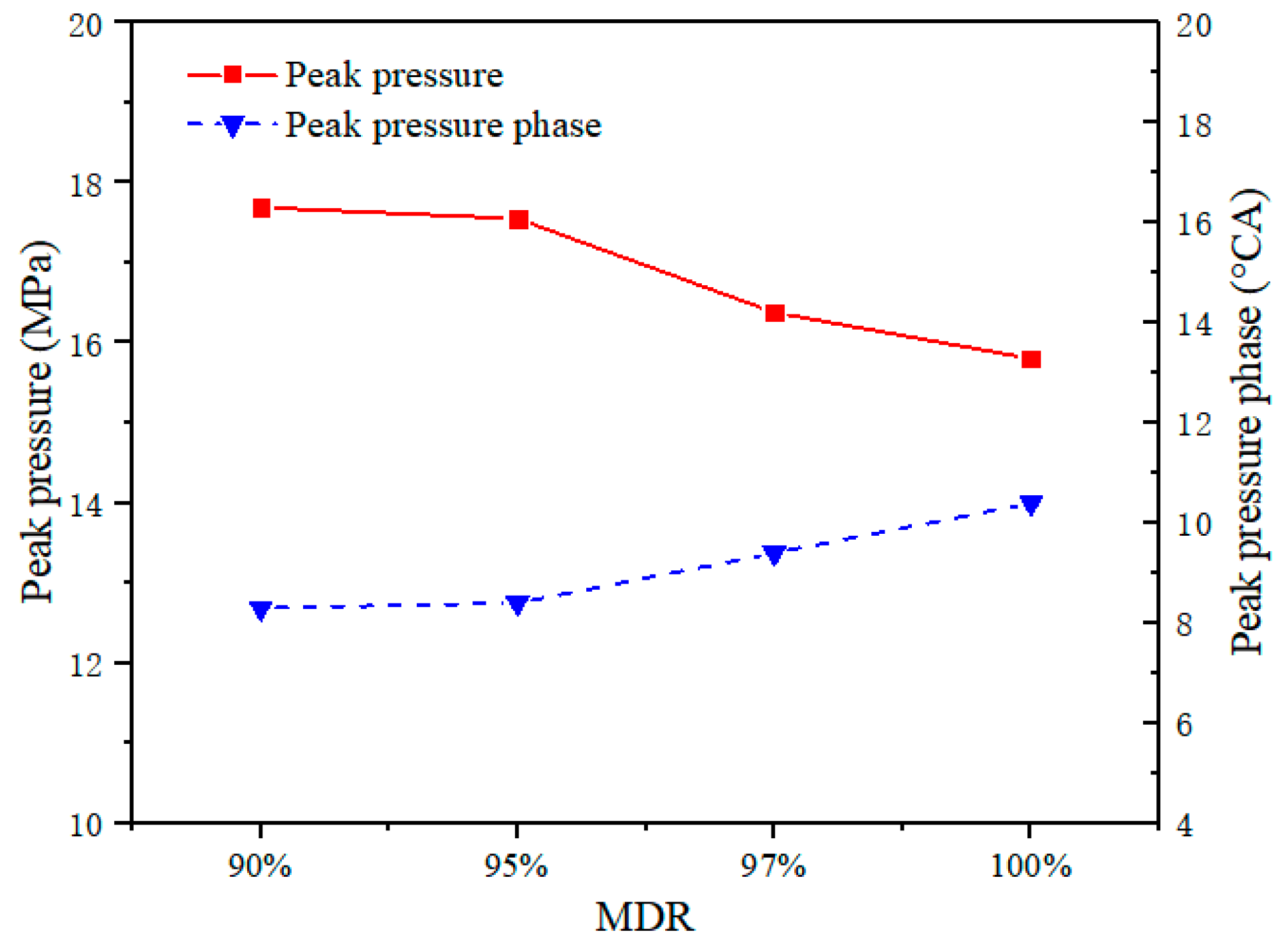
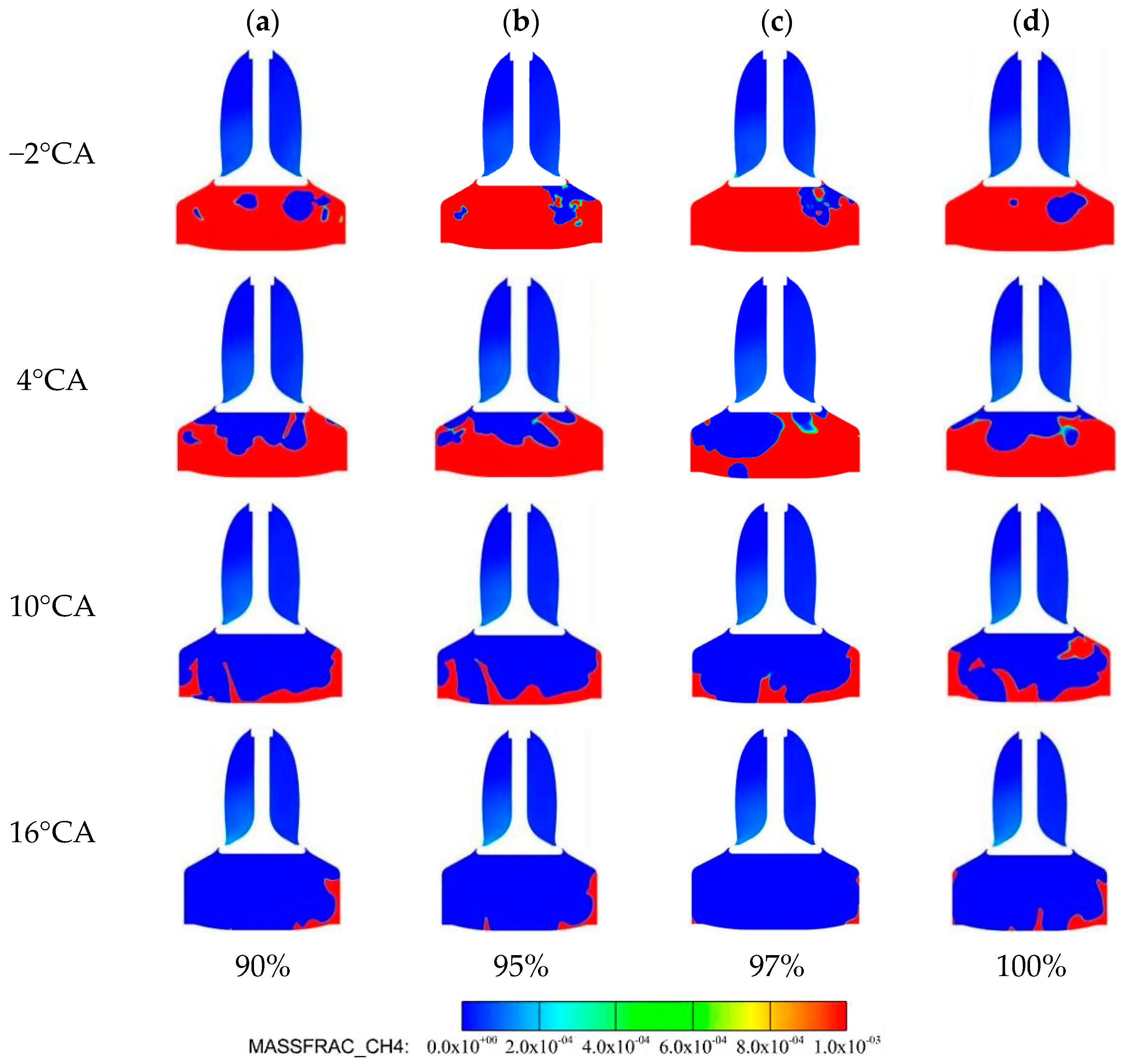
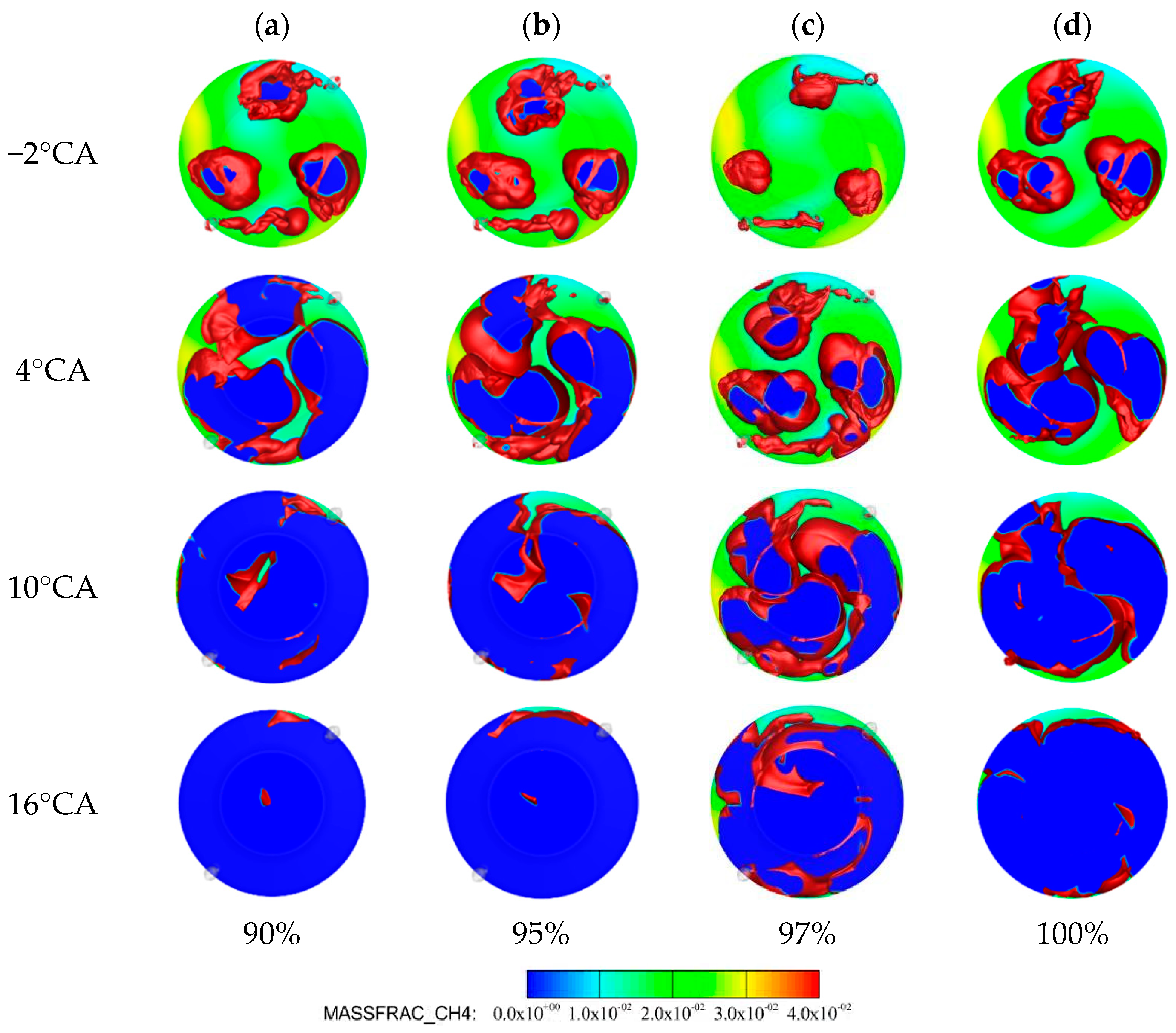
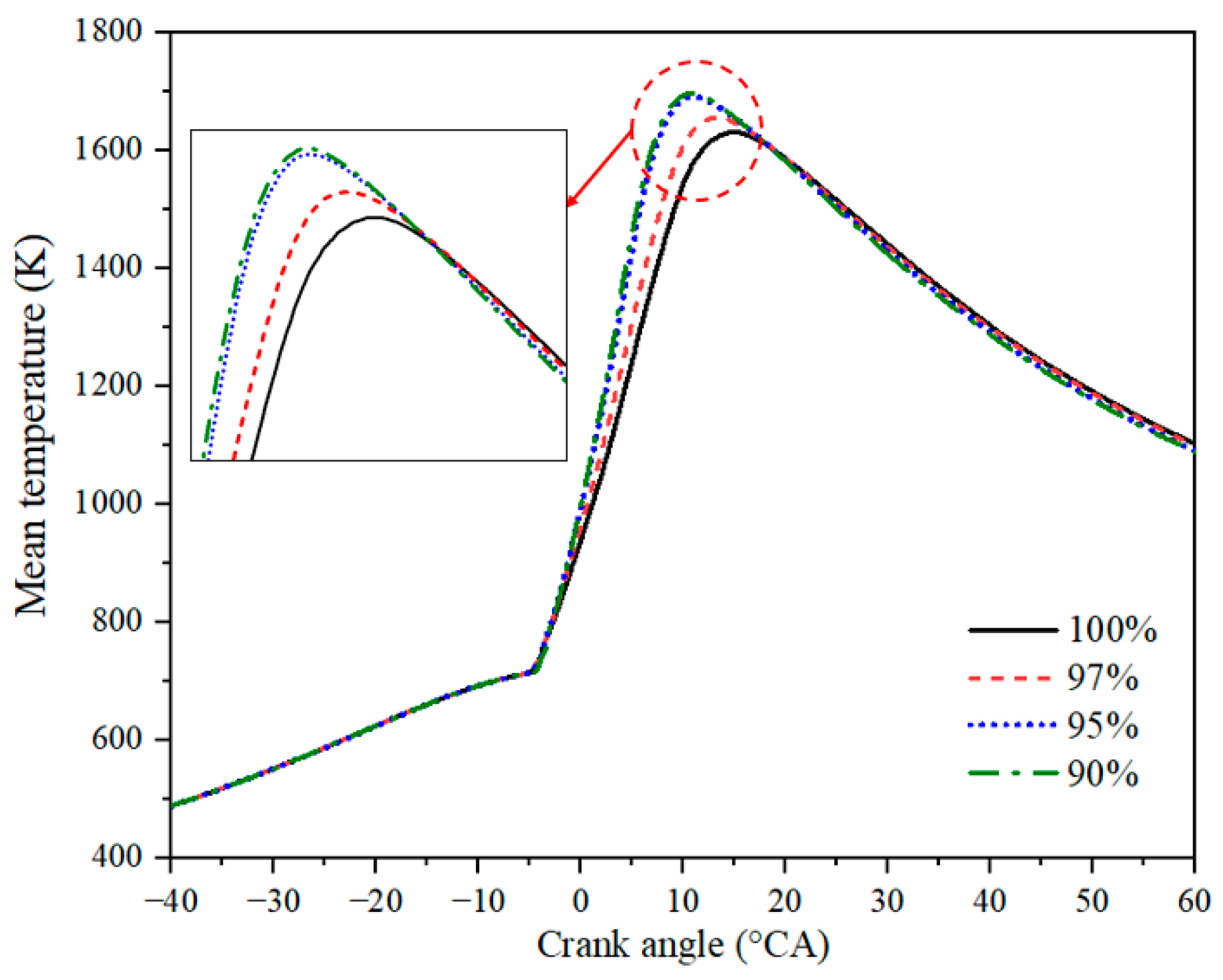


| Parameters | Value |
|---|---|
| Engine | X92DF |
| Cylinder number | 12 |
| Bore × Stroke (mm) | 920/3468 |
| Compression ratio | 12.4 |
| Speed (rpm) | 80 |
| Power (kW) | 63,840 |
| Brake mean effective pressure (bar) | 17.3 |
| Fuel | NG/diesel |
| Parameters | Value |
|---|---|
| Engine load (%) | 100% |
| Initial pressure (bar) | 12.1 |
| Initial temperature (K) | 930 |
| Inlet pressure (bar) | 4.7 |
| Outlet pressure (bar) | 4.55 |
| SOI of pilot diesel (°CA) | −7/−5/−3/−1 |
| SOI of main diesel (°CA) | −8/−6/−4/−2 |
| SOI of natural gas (°CA) | −118.8 |
| Exhaust valve open-close (°CA) | 92.6–290 |
Disclaimer/Publisher’s Note: The statements, opinions and data contained in all publications are solely those of the individual author(s) and contributor(s) and not of MDPI and/or the editor(s). MDPI and/or the editor(s) disclaim responsibility for any injury to people or property resulting from any ideas, methods, instructions or products referred to in the content. |
© 2024 by the authors. Licensee MDPI, Basel, Switzerland. This article is an open access article distributed under the terms and conditions of the Creative Commons Attribution (CC BY) license (https://creativecommons.org/licenses/by/4.0/).
Share and Cite
Liu, L.; Liu, S.; Liu, D. Research on the Ignition Strategy of Diesel Direct Injection Combined with Jet Flame on the Combustion Character of Natural Gas in a Dual-Fuel Marine Engine. J. Mar. Sci. Eng. 2024, 12, 857. https://doi.org/10.3390/jmse12060857
Liu L, Liu S, Liu D. Research on the Ignition Strategy of Diesel Direct Injection Combined with Jet Flame on the Combustion Character of Natural Gas in a Dual-Fuel Marine Engine. Journal of Marine Science and Engineering. 2024; 12(6):857. https://doi.org/10.3390/jmse12060857
Chicago/Turabian StyleLiu, Long, Shihai Liu, and Dai Liu. 2024. "Research on the Ignition Strategy of Diesel Direct Injection Combined with Jet Flame on the Combustion Character of Natural Gas in a Dual-Fuel Marine Engine" Journal of Marine Science and Engineering 12, no. 6: 857. https://doi.org/10.3390/jmse12060857
APA StyleLiu, L., Liu, S., & Liu, D. (2024). Research on the Ignition Strategy of Diesel Direct Injection Combined with Jet Flame on the Combustion Character of Natural Gas in a Dual-Fuel Marine Engine. Journal of Marine Science and Engineering, 12(6), 857. https://doi.org/10.3390/jmse12060857









